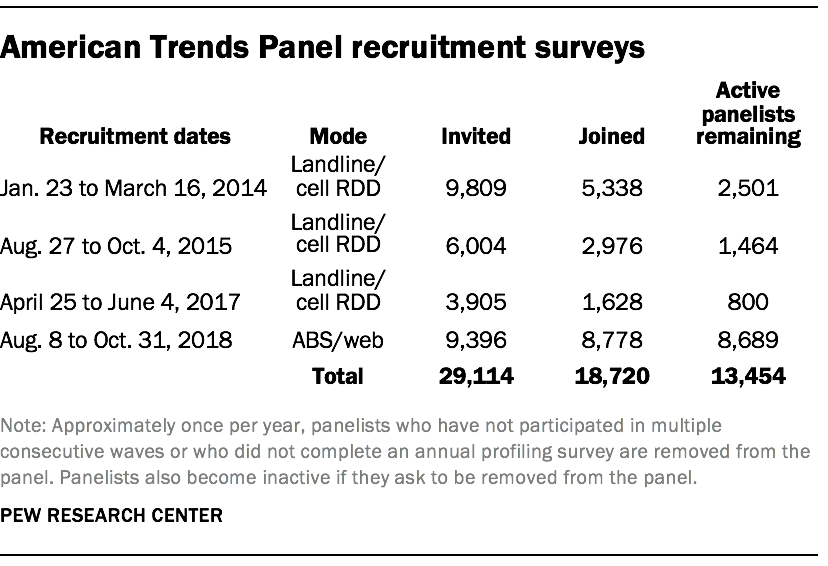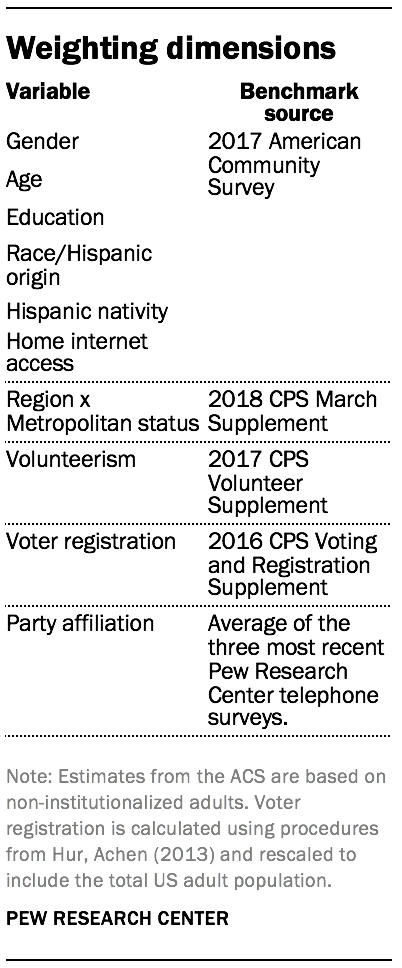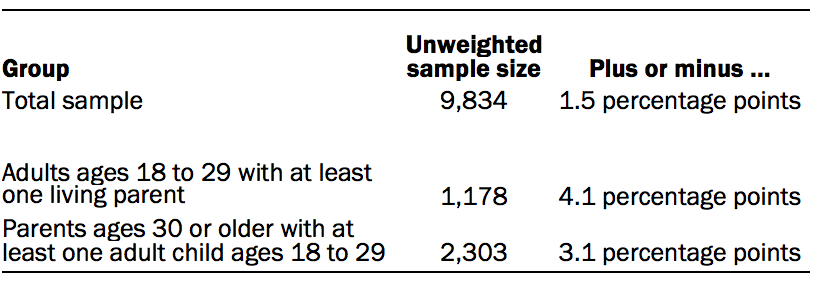The American Trends Panel (ATP), created by Pew Research Center, is a nationally representative panel of randomly selected U.S. adults. Panelists participate via self-administered web surveys. Panelists who do not have internet access at home are provided with a tablet and wireless internet connection. The panel is being managed by Ipsos.

Data in this report are drawn from the panel wave conducted June 25 to July 8, 2019. A total of 9,834 panelists responded out of 13,454 who were sampled, for a response rate of 73%. This does not include 11 panelists who were removed from the data due to extremely high rates of refusal or straightlining. The cumulative response rate accounting for nonresponse to the recruitment surveys and attrition is 3.5%. The break-off rate among panelists who logged onto the survey and completed at least one item is 1%. The margin of sampling error for the full sample of 9,834 respondents is plus or minus 1.5 percentage points.
The ATP was created in 2014, with the first cohort of panelists invited to join the panel at the end of a large, national, landline and cellphone random-digit-dial survey that was conducted in both English and Spanish. Two additional recruitments were conducted using the same method in 2015 and 2017, respectively. Across these three surveys, a total of 19,718 adults were invited to join the ATP, of which 9,942 agreed to participate.
In August 2018, the ATP switched from telephone to address-based recruitment. Invitations were sent to a random, address-based sample (ABS) of households selected from the U.S. Postal Service’s Delivery Sequence File. In each household, the adult with the next birthday was asked to go online to complete a survey, at the end of which they were invited to join the panel. For a random half-sample of invitations, households without internet access were instructed to return a postcard. These households were contacted by telephone and sent a tablet if they agreed to participate. A total of 9,396 were invited to join the panel, and 8,778 agreed to join the panel and completed an initial profile survey. Of the 18,720 individuals who have ever joined the ATP, 13,454 remained active panelists and continued to receive survey invitations at the time this survey was conducted.

The U.S. Postal Service’s Delivery Sequence File has been estimated to cover as much as 98% of the population, although some studies suggest that the coverage could be in the low 90% range.5
Weighting
The ATP data were weighted in a multistep process that begins with a base weight incorporating the respondents’ original survey selection probability and the fact that in 2014 and 2017 some respondents were subsampled for invitation to the panel. The next step in the weighting uses an iterative technique that aligns the sample to population benchmarks on the dimensions listed in the accompanying table.
Sampling errors and test of statistical significance take into account the effect of weighting. Interviews are conducted in both English and Spanish, but the American Trends Panel’s Hispanic sample is predominantly U.S. born and English speaking.
In addition to sampling error, one should bear in mind that question wording and practical difficulties in conducting surveys can introduce error or bias into the findings of opinion polls.
The following table shows the unweighted sample sizes and the error attributable to sampling that would be expected at the 95% level of confidence for different groups in the survey:

Sample sizes and sampling errors for other subgroups are available upon request.
Telephone survey methodology
The analysis of the question about the age at which children should have to be financially independent from their parents is based on telephone interviews conducted June 25 to June 30, 2019, among a national sample of 1,015 adults, ages 18 and older, living in the United States (306 respondents were interviewed on a landline telephone, and 709 were interviewed on a cellphone, including 481 who had no landline telephone). The survey was conducted under the direction of SSRS. A combination of landline and cellphone random-digit-dial samples were used; both samples were provided by Marketing Systems Group. Interviews were conducted in English and Spanish. Respondents in the landline sample were selected by randomly asking for the youngest adult male or female who is now at home. Interviews in the cell sample were conducted with the person who answered the phone if that person was an adult age 18 or older.
For detailed information about our survey methodology, see http://www.pewresearch.org/methodology/u-s-survey-research/
The combined landline and cellphone sample are weighted to provide nationally representative estimates of the adult population ages 18 and older. The weighting process takes into account the disproportionate probabilities of household and respondent selection due to the number of separate telephone landlines and cellphones answered by respondents and their households, as well as the probability associated with the random selection of an individual household member. Following application of the above weights, the sample is post-stratified and balanced by key demographics such as age, race, sex, region, education and Hispanic nativity. The sample is also weighted to reflect the distribution of phone usage in the general population, meaning the proportion of those who are cellphone only, landline only, and mixed users.
The following table shows the unweighted sample size and the error attributable to sampling that would be expected at the 95% level of confidence in the survey:

Sample sizes and sampling errors for other subgroups are available upon request.
In addition to sampling error, one should bear in mind that question wording and practical difficulties in conducting surveys can introduce error or bias into the findings of opinion polls.
Pew Research Center undertakes all polling activity, including calls to mobile telephone numbers, in compliance with the Telephone Consumer Protection Act and other applicable laws.
Secondary data sources and methodology
Most of the census data in this report are derived from the Current Population Survey Annual Social and Economic Supplement (ASEC), which is conducted in March of every year. Conducted jointly by the U.S. Census Bureau and the Bureau of Labor Statistics, the CPS is a monthly survey of approximately 60,000 households and is the source of the nation’s official statistics on unemployment. The ASEC survey in March features a larger sample size. Data on income and poverty from the ASEC survey serve as the basis for the well-known Census Bureau report on income and poverty in the United States.
The CPS is representative of the civilian non-institutionalized population.
The college enrollment information is derived from the annual school enrollment supplement to the CPS. Conducted during October, the supplement is the basis for the bureau’s historical tables on college-going.
Information on the share of women who have given birth is based on the periodic fertility supplement to the CPS. The supplement is conducted in June every other year.
The CPS microdata used in this report are the Integrated Public Use Microdata Series (IPUMS) provided by the University of Minnesota. IPUMS assigns uniform codes, to the extent possible, to data collected in the CPS over the years. More information about IPUMS, including variable definitions and sampling error, is available at http://cps.ipums.org/cps/documentation.shtml.
© Pew Research Center, 2019




